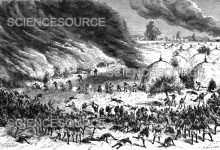The Battle of Naukluf (1894): An Examination of the German Colonial Campaign in Africa
The Battle of Naukluf, which took place in 1894, stands as a significant, albeit tragic, chapter in the history of German colonialism in Africa. This conflict was part of the larger series of engagements known as the German Colonial Wars, a period marked by brutal confrontations between the German Empire and various indigenous tribes across the African continent. The particular battle is emblematic of the German colonial expansion into present-day Namibia and the devastating effects it had on local populations, particularly the Nama tribe.
The Context: The German Colonial Wars in Africa
The late 19th century was a time of intense imperial competition among European powers. The so-called Scramble for Africa saw various European nations vie for territorial control over large parts of the African continent. Germany, although a late entrant into the colonial race, quickly established a presence in several African territories. This was formalized through the creation of German South West Africa, an area that today encompasses Namibia.
The Nama tribe, a group of indigenous people living in the southern part of Namibia, came into direct conflict with the German authorities as part of their broader efforts to secure and expand German control in the region. The German Colonial Wars in Africa, which included the Herero and Namaqua Wars, were notorious for their brutal tactics, where indigenous resistance was met with overwhelming force and colonial military superiority.
Prelude to the Battle of Naukluf
By the early 1890s, the Germans had firmly established themselves in the region, but the Nama people, led by resistance leaders such as Hendrik Witbooi, were determined to fight against foreign domination. Witbooi’s resistance was part of a larger movement to prevent the encroachment of German settlers and the imposition of colonial rule.
The Battle of Naukluf took place during this period of escalating tension. The location, near the Naukluf Mountains in the Namib Desert, would become the stage for a confrontation between German forces and the Nama resistance.
Participants in the Battle
The battle involved German forces, composed largely of colonial troops known as Schutztruppe, which was the German colonial army, alongside local auxiliary forces. These forces were better equipped, trained, and supported by European military technology. In contrast, the Nama tribe was far less equipped to withstand such a well-organized and resource-rich opponent.
Despite being outnumbered and outgunned, the Nama warriors, led by their tribal leaders, attempted to mount a defense against the advancing German troops. The resistance from the Nama tribe was fierce, but they faced insurmountable odds. The German forces, determined to quell any resistance to their rule, brought overwhelming force to the engagement.
The Battle and Its Outcome
The battle itself was brief but intense. The superior firepower and organization of the German forces ultimately ensured their victory. Despite their brave resistance, the Nama tribe was decisively defeated. The Germans, having established military dominance, were able to impose further control over the region. The Nama tribe’s defeat at Naukluf was one of the many in a series of conflicts that would continue throughout the colonial era.
Germany’s victory in the battle allowed them to tighten their hold over the area. For the Nama tribe, the loss was devastating, not only in terms of military defeat but also in the severe consequences it brought for their people. The subsequent German expansion into Nama territories led to the erosion of traditional structures and forced labor under colonial authorities.
Aftermath and Impact
The Battle of Naukluf was part of a broader pattern of military conflicts between the German Empire and indigenous groups in Namibia. This was not an isolated battle but rather a significant moment in the larger Nama and Herero Wars that would unfold over the next decade. The Nama people, already suffering from harsh conditions under colonial rule, faced further violence and repression after the battle.
While there was no formal massacre at Naukluf, the aftermath of the battle contributed to the greater suffering of the Nama tribe. The German colonial forces, continuing their military and cultural dominance, forced the local population into labor camps, subjected them to violence, and restricted their movements. The Nama, like the Herero people, would eventually face even harsher repercussions during the notorious German genocide campaigns that targeted indigenous groups in the early 20th century.
The Nama people’s defeat at Naukluf, however, did not extinguish their desire for resistance. Over the years, leaders like Hendrik Witbooi continued to lead guerrilla attacks against German forces, although the imbalance of power increasingly worked in favor of the colonizers. This long-standing resistance ultimately led to the Nama tribe being subjected to one of the most brutal forms of colonial rule in Africa.
Conclusion
The Battle of Naukluf in 1894 remains a somber reminder of the brutal tactics employed during the era of European colonialism in Africa. While the Germans emerged victorious, the human cost of the conflict was high. The Nama tribe suffered immensely under German occupation, a theme that would continue throughout the colonial era. The larger German Colonial Wars in Africa left scars that lasted long after the German Empire’s formal colonial hold ended, shaping the modern history of Namibia and its people.
Understanding events like the Battle of Naukluf is crucial in appreciating the resilience of indigenous peoples in the face of colonial oppression. The legacy of these battles continues to influence the socio-political landscape of Namibia today, as the nation grapples with the consequences of its colonial past.

